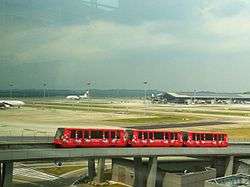
Aerotrain (GM)
The Aerotrain was a streamlined trainset introduced by General Motors Electro-Motive Division in the mid-1950s. Like all of GM's body designs of this mid-century era, this train was first brought to life in GM's Styling Section. Chuck Jordan was in charge of designing the Aerotrain as Chief Designer of Special Projects. It utilized the experimental EMD LWT12 locomotive (U.S. Patent D177,814), coupled to a set of modified GM Truck & Coach Division 40-seat intercity highway bus bodies (U.S. Patent D179,006). The cars each rode on two axles with an air suspension system, which was intended to give a smooth ride, but had the opposite effect.
History
The two Aerotrain demonstrator sets logged over 600,000 miles (970,000 km) and saw service on the following railroads:
Starting in February 1956 the Pennsylvania Railroad ran the Pennsy Aerotrain between New York City and Pittsburgh, Pennsylvania, leaving New York at 7:55 a.m.; the round trip was scheduled 7 hours, 30 minutes. From June 1956 to June 1957 it ran between Philadelphia and Pittsburgh.
Aerotrain
Aerotrain may refer to:

Aerotrain (KLIA)
The Aerotrain is an automated people mover (APM) system located within the Kuala Lumpur International Airport in Malaysia.
Opened in 1998 along with the airport, the Aerotrain system consists of two stations, one in the Main Terminal Building and the other in Satellite Building A. The system is the only means of transport for passengers between the two terminals.
Upgrading works on the Aerotrain had caused the service to be suspended between November 1, 2010 and March 15, 2011. Passengers were transferred between the Main Terminal Building and the Satellite Building by bus shuttles during the upgrading period.
General information
The Aerotrain is fully automated and driverless. Usually, two trains ply between the two stations. In accordance with the Spanish solution, when the train reaches the platform, the exit doors will open first for passengers to disembark, after which the entrance door on the other side will open.
Part of the train track goes underground to cross the taxiway. The ride between the Main Terminal Building and Satellite Terminal A takes about 2.5 minutes.

Aérotrain
The Aérotrain was a hovertrain developed in France from 1965 to 1977. The lead engineer was Jean Bertin.
The goal of the Aérotrain was similar to that of the magnetic levitation train: to suspend the train above the tracks so the only resistance is that of air resistance. Consequently, the Aérotrain could travel at very high speeds without the technical complexity and expensive tracks of magnetic levitation.
This project was abandoned in 1977 due to lack of funding, the death of Jean Bertin, and the adoption of TGV by the French government as its high-speed ground-transport solution.
Test tracks
The track for most Aérotrains are ferroconcrete monorail in an inverted 'T' shape. All tracks were built and used for experimental purposes.
Podcasts:

